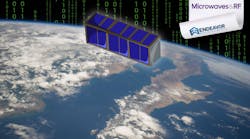This Microwaves & RF article is reprinted here with permission.
CubeSats may be small as satellites go, but now they can house a high-performance image-analysis system for detailed observation of Earth from orbit. The system was developed by the Centre Spatial Universitaire de Grenoble (CSUG) working with Teledyne e2v and unveiled at the recent Space Tech Expo 2021. It's designed to operate within the confines of 6U CubeSats measuring just 10 × 20 × 30 cm (see the figure). The heart of the system is a quad-core 1.8-GHz Qormino QLS1046-Space microprocessor module from Teledyne e2v with 64-b Arm Cortex A72 microprocessor cores accompanied by 4-GB DDR4 memory. Imaging data is captured with a 16-Mpixel Emerald CMOS image sensor, also from Teledyne e2v.
The two organizations have worked as partners for more than four years, with Teledyne e2v agreeing to full sponsorship of the QlevEr Sat project in March 2020. The imaging system, planned for launch in early 2022, is designed to acquire large-area images with the aid of artificial intelligence (AI), using an AI algorithm developed by the Multidisciplinary Institute in Artificial Intelligence (MIAI). The system provides capabilities suitable for many applications, such as identifying areas of deforestation, damage from natural or man-made disasters, glacial and oceanic analysis, and monitoring of volcanic activity in addition to defense-related tasks. Qormino modules undergo intense screening and testing to ensure that they can effectively weather the hostile operating conditions of space. Modules can handle total ionizing dose (TID) levels higher than 100 krad and feature single-event-latchup (SEL) resilience of 60 MeV-cm2/mg over a wide operating temperature range of -55 to +125°C.
Tania McNamara, Project Manager at CSUG, explained: “Integrating AI capabilities directly into CubeSats will dramatically reduce the amount of bandwidth needed for data transmission, which is clearly beneficial given the rising number of satellites now in orbit.” She added: “We envisage the system being utilized to address numerous use cases where changes on the Earth’s surface need to be surveyed.” Thomas Porchez, Application Engineer at Teledyne e2v, offered: “By combining our next-generation processing, memory, and optoelectronic devices with the cutting-edge AI technology developed, QlevEr Sat overcomes these challenges. It enables image capture and subsequent processing to be carried out in even the smallest of satellite designs. Consequently, we see a lot of opportunities emerging for it.”
